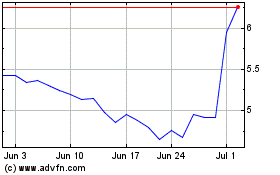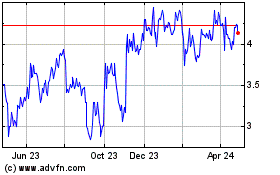Fast and Free Shipping, Free and Easy Returns,
Accurate Tracking and On-time Deliveries Top Online Shoppers’ Wish
Lists this Holiday Season
Pitney Bowes (NYSE: PBI), a global technology company that
provides commerce solutions in the areas of ecommerce, shipping,
mailing, data and financial services, today released the results of
its annual Online Shopping Study. Among the Study’s key findings:
60% of online shoppers in the US are dissatisfied with their
holiday shopping experiences, up four percentage points from last
year, and nearly double the number from just four years ago.
This press release features multimedia. View
the full release here:
https://www.businesswire.com/news/home/20191107005167/en/
Pitney Bowes Online Shopping Study 2019
(Graphic: Business Wire)
The Study also found that the more often you shop, the more
likely you are to be frustrated. Seventy-three percent of frequent
online shoppers (those who shop online daily, or weekly) and 74% of
millennials said they were disappointed in some aspect of the
post-purchase experience last holiday season.
The top three reasons for consumer frustration are: delayed
shipments; shipping costs; and inaccurate tracking.
“Despite the significant investments retailers and marketplaces
are making in the online shopping experience, consumers continue to
be disappointed, especially around the holidays,” said Lila Snyder,
EVP and President, Commerce Services at Pitney Bowes. “As an even
larger percentage of consumer spending is expected to shift online
this holiday season, retailers need to shift resources and
investments to areas like fast and free shipping, accurate tracking
and free and easy returns to keep up with consumer
expectations.”
Root Canals and Revenge
This year’s Study included a number of questions asking
consumers to associate an online shopping experience with an
emotion (“love it! / hate it.”), or a range of universally
enjoyable, or unpleasant experiences, such as “taking a vacation”
or “having a root canal.”
For example, 86% equated some aspect of a poor post-purchase
experience to “having a root canal,” especially these unpleasant
events:
- receiving a wrong or damaged item 72%
- taking too long to get a refund after returning an item
64%
- an inconvenient returns process 60%
- having to pay for shipping 47%
When a retailer puts a consumer through one of these unpleasant
experiences, they do so to the detriment of their brand. For the
second year in a row, nearly nine out of 10 consumers said that
they will make a complaint or take an action that could hurt a
brand’s reputation and bottom line following a bad post-purchase
experience. Among them, nearly one-third said a bad post-purchase
experience is cause for never shopping with the offending brand
again.
Fast and Free Shipping, and Free and Easy Returns
On the bright side, online shoppers did offer advice to
retailers and marketplaces about how they can improve the
post-purchase experience, particularly around fast and free
shipping, and free and easy returns.
Free shipping remains the number one loyalty driver an online
retailer can offer consumers. In fact, when given the choice
between “free” shipping or “fast” shipping” 80% choose “free,”
consistent with data collected in each of the past three years.
Free shipping was four times more likely to drive consumer loyalty
than any other feature that a retailer could offer.
In addition to fast and free shipping, consumers want a free and
easy returns process and fast refunds. On average, Amazon refunds
consumers 4.5 times faster than other brands.
Returns are on the rise and 51% of all online shoppers,
including 66% of millennials, now admit to “bracketing” –
purchasing multiple sizes, styles and colors of an item with the
intent to return what they don’t want.
Seventy-two percent said they “love” when a return label is
included in the package. Seventy percent said they “hate” paying
for return shipping even more than missing the returns period and
getting stuck with an unwanted item (61%).
“Returns seem to have become an unconscious behavior for some
frequent online shoppers,” said Snyder. “In response to our survey,
consumers said they return only 10% of their online purchases, but
in reality we know the number is much closer to 25%.”
Sixty-six percent of consumers said they “love” home pick-up for
returns. Home pick-up is three times more popular than carrier
drop-off and four times more popular than in-store drop-off. When
home pick-up of a return is not offered by a retailer, consumers
admit to compounding the delays by taking, on average, four more
days of what Snyder calls, “trunk time” to transport their item
from their home to the carrier, or store.
Cross-Border Shopping
The number of cross-border shoppers continues to grow in
countries like Australia, Canada, China, Mexico and UK. Of the
countries we surveyed, only the US saw a year-over-year decline in
the number of cross-border shoppers. Forty-six percent of online
shoppers in the US say they have made a cross-border purchase in
the past year, versus 49% the year prior.
Of the US consumers who do shop cross-border, nine out of 10
have purchased something from China. Expectations among
cross-border shoppers are not dissimilar to those of domestic
shoppers, but frustrations with late deliveries and inaccurate
tracking are higher, especially on items ordered from China.
Methodology: The 2019 Pitney Bowes Online Shopping Study is
based on survey results of more than 8,000 consumers globally.
Unless otherwise noted, the information in this press release is
based on survey results of more than 3,000 US consumers, ages 18
and up.
The Pitney Bowes Online Shopping Study is one of two annual
research reports the company conducts on behalf of its clients and
releases publicly. In October, the Company released its annual
Parcel Shipping Index which measures parcel volume and spend across
13 major markets globally. The Index found that annual parcel
volumes reached 87 billion in 2018 (17% year-over-year growth) and
are projected to reach 200 billion in 2025.
Pitney Bowes can help
Pitney Bowes supports retailers and other shippers in the areas
of fulfillment, delivery, returns and cross-border. In each of
these areas, the Company strives to be the service provider that’s
easiest to work with, by being more transparent and offering
simpler pricing with fewer and lower surcharges than others in the
market.
Services include:
- Fulfillment services with a nationwide network, automated
facilities and seamlessly integrated delivery and returns;
- Standard delivery of parcels through an extensive US domestic
network, leveraging the USPS® for final mile delivery;
- Cross-border delivery to 207 countries and territories with
bundled quoting and compliance services; and
- Standard domestic returns services that allow retailers to
offer free at-home pick-up, convenient drop-off options, and fast
refunds.
Pitney Bowes ranked as a top vendor in the International
Ecommerce Services, Fulfillment Services and Shipping Carrier
categories in Internet Retailer’s “2019 Leading Vendors to the Top
1000” E-Retailers report.
About Pitney Bowes
Pitney Bowes (NYSE: PBI) is a global technology company
providing commerce solutions that power billions of transactions.
Clients around the world, including 90 percent of the Fortune 500,
rely on the accuracy and precision delivered by Pitney Bowes
solutions, analytics, and APIs in the areas of ecommerce
fulfillment, shipping and returns; cross-border ecommerce; office
mailing and shipping; presort services; location data; customer
information and engagement software; services; and financing. For
nearly 100 years Pitney Bowes has been innovating and delivering
technologies that remove the complexity of getting commerce
transactions precisely right. For additional information visit
Pitney Bowes, the Craftsmen of Commerce, at
www.pitneybowes.com.
View source
version on businesswire.com: https://www.businesswire.com/news/home/20191107005167/en/
Brett Cody Pitney Bowes M +1 203 218 1187 brett.cody@pb.com
Pitney Bowes (NYSE:PBI)
Historical Stock Chart
From Jul 2024 to Aug 2024

Pitney Bowes (NYSE:PBI)
Historical Stock Chart
From Aug 2023 to Aug 2024
